All the solutions provided in McGraw Hill Math Grade 5 Answer Key PDF Chapter 10 Test are as per the latest syllabus guidelines.
McGraw-Hill Math Grade 5 Chapter 10 Test Answer Key
Use the diagram for exercises 1-3.
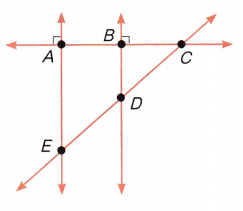
Question 1.
Identify two line segments.
Answer:
A line segment is part of a line and it has two end points.
One line segment is AB.
Second line segment is DC.
Question 2.
Identify two parallel lines.
Answer:
Parallel lines never meet and the lines are equidistant from each other.
The two parallel lines are AE and BD.
Question 3.
Identify two intersecting lines that are not perpendicular.
Answer:
The two intersecting lines that are not perpendicular are AE and CE.
Classify each angle as straight, right, obtuse, or acute. Then, use a protractor to measure each angle. You may need to extend its sides.
Question 4.

Answer:

Acute angle
Explanation:
In the above image we can observe the measured angle 22 degrees. The angle which measures less than 90 degrees is called as acute angle. So, the above angle is acute angle.
Question 5.

Answer:

Obtuse angle
Explanation:
In the above image we can observe the measured angle 164 degrees. The angle which measures greater than 90 degrees and less than 180 degrees is called as obtuse angle. So, the above angle is obtuse angle.
Question 6.
![]()
Answer:
![]()
Explanation:
In the above image we can observe the measured angle 180 degrees. The angle which measures exactly 180 degrees is called as straight angle. So, the above angle is straight angle.
Question 7.
Place a checkmark under the equilateral triangle.

Answer:

Explanation:
An equilateral triangle has three sides of equal length. In the above image we can observe four triangles, in that first triangle having three sides with a same length as 4 m. So, the above first triangle is equilateral triangle. So, placed a checkmark under the equilateral triangle.
Question 8.
Which shape is not a polygon? Place a checkmark under it.

Answer:

Explanation:
A polygon is a closed figure having finite number of line segments. In the above shapes, the third shape circle is not a polygon. Because a circle is made up of points which is equidistant from center. So, placed a checkmark under the third shape circle.
Question 9.
Place a checkmark under the trapezoid.

Answer:

Explanation:
A trapezoid has four sides and having one pair of parallel sides. In the above image we can observe four different shapes. In that first shape is trapezoid. So, placed a checkmark under the first shape trapezoid.
Find the area of each shape.
Question 10.

Answer:
Given
length = 13 m
Width = 5 m
Area of the rectangle (A) = length x width
A = 13 m x 5m
A = 65 square meters
Area of the rectangle is equal to 65 square meters.
Question 11.
a square with one side measuring 17 cm
Answer:
Given one Side of the square = 17 cm
In square all sides are equal.
Area of the square (A) = Side x Side
A = 17 cm x 17 cm
A = 289 square centimeters
Area of the square is equal to 289 square centimeters.
Find the volume of each object.
Question 12.
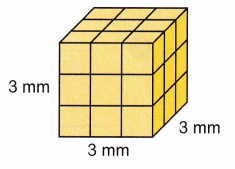
Answer:
Volume = length x width x height
volume = 3 mm x 3 mm x 3 mm = 27 cubic millimeters
Since the measure is in mm, the volume of the object is 27 cubic millimeters.
Question 13.
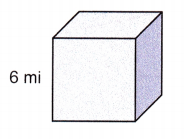
Answer:
The above object is square, so length, width and height are equal to 6 mi
Volume of the square object (V) = (length x width) x height
V = (6 mi x 6 mi) x 6 mi
V = 216 cubic mi
The volume of square object is 216 cubic mi.
Question 14.
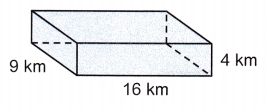
Answer:
From the above object,
length = 16 km
Width = 9 km
Height = 4 km
Volume of the rectangular object (V) = (length x width) x height
V = (16 km x 9 km) x 4 km
V = 144 square km x 4 km
V = 576 cubic kilometers
The volume of rectangular object is 576 cubic kilometers.
Question 15.
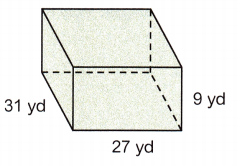
Answer:
From the above object,
length = 27 yards
Width = 31 yards
Height = 9 yards
Volume of the rectangular object (V) = (length x width) x height
V = (27 yd x 31 yd) x 9 yd
V = 837 square yards x 9 yd
V = 7,533 cubic yards
The volume of rectangular object is 7,533 cubic yards.
Question 16.
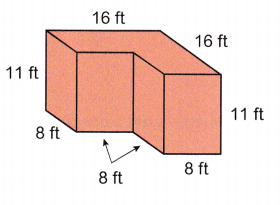
Answer:

Explanation:
First we have to separate the given object into two solids then we have to find the volume of each solid.
Volume of one solid:
Length (l) = 16 feet
Width (w) = 8 feet
height (h) = 11 feet
Volume (v) = (l x w) x h
v = (16 ft x 8 ft) x 11 ft
v = 1,408 cubic feet
Volume of another solid:
Length (l) = 8 feet
Width (w) = 8 feet
height (h) = 11 feet
Volume (v) = (l x w) x h
v = (8 ft x 8 ft) x 11 ft
v =704 cubic feet
Now we have to add the two volumes.
1,408 cubic feet + 704 cubic feet = 2,112 cubic feet
The volume of the object is 2,112 cubic feet.
Question 17.

Answer:

Explanation:
First we have to separate the given object into two rectangular prisms then we have to find the volume of each solid.
Volume of one rectangular prism:
Length (l) = 13 cm
Width (w) = 10 cm
height (h) = 2 cm
Volume (v) = (l x w) x h
v = (13 cm x 10 cm) x 2 cm
v = 260 cubic centimeters
Volume of another rectangular prism:
Length (l) = 13 cm
Width (w) = 6 cm
height (h) = 4 cm
Volume (v) = (l x w) x h
v = (13 cm x 6 cm) x 4 cm
v = 312 cubic centimeters
Now we have to add the two volumes.
260 cubic centimeters + 312 cubic centimeters = 572 cubic centimeters
The volume of the object is 572 cubic centimeters.